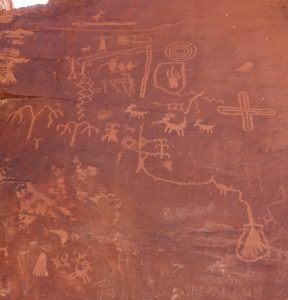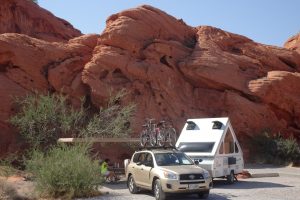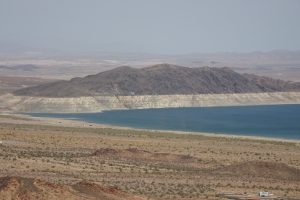15-17 August: On our way to the southern tip of Nevada from Utah, we drove across the northwestern corner of Arizona, where Virgin River Canyon offered great views along Interstate 15. We were looking forward to seeing some of the colorful rock formations in Valley of Fire State Park, which first came to our notice when a view from it was featured on the postage stamp celebrating Nevada’s sesquicentennial in 2014. Our hiking friend Judith had warned us that it would be hot there, and she certainly wasn’t exaggerating! We camped there two nights and the temperature never seemed to drop into double digits, even at night. We opted for short hikes, avoiding the peak midday heat. A couple of short walks led to viewpoints of ancient petroglyphs, and a loop hike the next morning led us through an area formerly used as a movie set for westerns.

At sunset of our first evening in Valley of Fire, a bighorn ram provided some entertainment. After running close by our campsite, he stopped three campsites down from ours. There he occupied himself for several minutes getting a drink from the water faucet, by alternately butting the pipe to make water spurt downward and then lapping from the puddle below.
The day we left Valley of Fire, we stopped to see the Lake Mead National Recreation Area visitor center near Hoover Dam and take a walk on the Historic Railroad Hiking Trail. The excellent visitor center displays included a large 3-D scale model of the lake and surrounding terrain, as well as descriptions of the dam construction. The hiking trail is the former bed of the railroad that was built and used for bringing equipment and supplies to the construction site of what was then named Boulder Dam (renamed Hoover Dam in 1947). Informational plaques along the trail gave us some historical perspective—as well as excuses for frequent stops for drinks of water. Tunnels along the way provided some welcome shade. It was sobering to see how low the water level in Lake Meade had become after recent years of drought in the region.



